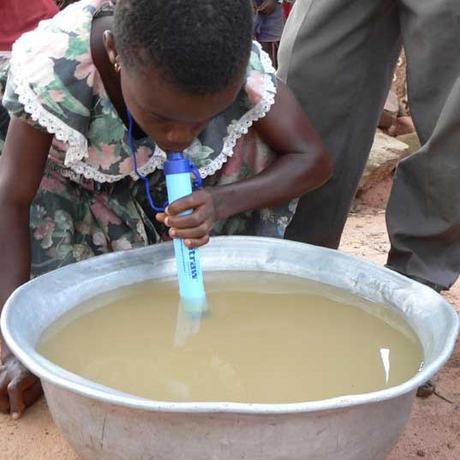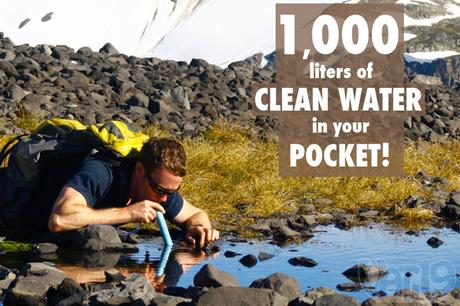While it would be great to be able to simply carry around enough water to make sure you always have something clean to drink, the reality of the weight of five gallons of water just makes that impossible. However, knowing how to Filter Water
The following pages will discuss some of your options for filtering water for survival. When filtering water, there are a few things you need to keep in mind:
* Filtration is highly effective for removing Giardia intestinalis and cryptosporidium if using a filter that is rated for 1.0 microns or less.
* Filtration is only moderately effective at removing bacteria such as E. coli, Salmonella, Campylobacter and Shigella when using filtration media rated for 0.3 microns or less.
* Filtering water is not effective at removing viruses from a water supply.

Given that filtration is less effective than boiling, it is recommended that you filter your water and then boil it to make sure it is as safe as possible to drink. This will help remove contaminants and kill bacteria and viruses that may be left after the filtration process.
Store-Bought Filtration As mentioned, there are many different filtration options available for purchase. These bottles and systems work in a variety of ways, and each one will provide greater filtration than that which you will get making your own. If you want to be truly prepared for any situation, opting for a filtration bottle or even a specialized straw will give you added protection without taking up a lot of space in your pack.
Using a filtration bottle will allow you to filter the water prior to boiling it. The straw, however, is designed to meet the standards set by the EPA for filtering parasites and bacteria. It also filters up to 1,000 liters of water, making it a smaller option that is quite effective.
Making Your Own Water Filtration Nearly any water source you might find is likely to be cloudy. That cloudiness is due to dirt, sediment and other contaminants. If you are in a situation in which you need to filter water but do not have a straw or filtration system, you can create your own.
If you are making your own water filtration device, you will want to make sure you can boil the water afterwards for increased safety and protection against waterborne illnesses as the following methods will not remove enough of the contaminants.
DIY Bio-filter

* Bark - You will want to shape a strip of bark into a cone shape.
* Grass
* Sand
* Gravel
* Charcoal - While the charcoal from your campfire won't filter as well as activated charcoal, it will work with the other materials to help clean the water.
Once you have these materials, layer them inside the cone starting with the charcoal. Place a layer of sand followed by the grass and end with a layer of gravel. The goal is to use enough materials so that the water actually percolates through the layers rather than simply flowing through them.
Filtering Water with Clothing If you are unable to find any of the above materials, you can also use articles of clean clothing to filter water. When using this method, you will need to filter the water several times until it actually becomes clear.
If you have an athletic sock and mesh pantyhose, place the hose inside the sock. You will then slowly pour the water into the top of the sock so that it can drain through into a clean container.
When pantyhose is not available, you can also place layers of clothing together. You will want to use clean clothing and you will need several layers. You will also have to move the layers around every so often so that the water is moving through clean layers. Your goal is to make it so that the water drips through the layers rather than pouring or trickling through them.
If clothing is the only option available for filtering, boiling the water becomes even more important. The mesh will catch and filter larger particles, but there is a much greater likelihood of smaller particles making their way into the water you are filtering.
Make Your Own Solar Still When it comes to a survival situation, one of the best options available to you is to use your gear to create a solar still. This method does take a bit of time, but you can be sure that the water will be safer to drink than the other methods of filtration.
To make a solar still, all you need are the following:
* A garbage bag or similar type of plastic sheet
* A piece of rubber tubing
* A container or pan
* Leaves and greenery
The first step in making your water still is to dig a hole in the ground that resembles an inverted cone. At the bottom of the hole, place the container or pan and anchor one end of your rubber tubing inside it. The other end of the tubing will be outside of the hole and you will need to make sure it is anchored too.
Place the greenery and leaves inside the hole, making sure that they do not cover or go over the top of the pan. Once everything is inside, place your garbage bag or plastic over the hole. Secure it so that the moisture stays inside rather than escaping.
Once you have the plastic secured, place a small stone or rock into the center of it so that it dips down over the top of the container inside it.
Your still will catch the water that evaporates from the greenery, leaves and the ground, which will lead to condensation on the plastic. As it is captured by the sheet, it will drip into your pan or container.
You will use the end of the tubing to get water from the container inside the still. This will also make it so that you do not have to open the still repeatedly. If you have enough plastic, tubing and containers, you should try to set up multiple stills since the evaporation process does take some time to complete.
Transpiration Bags Another option for gathering potable water is transpiration. As you can see in the image above, the natural water cycle involves the rain falling. The plants collect this rain when it reaches their root systems, and the water moves through the plant and out through the leaves, along with oxygen, through a process known as transpiration.
If you are in an emergency situation, you can take advantage of this process to gather potable water. All you need is a bag that you can secure around plants that are growing in the area and enough time to wait so that you can gather drinking water.
All you have to do is tie or secure a clean plastic bag around the leaves on the plants. Within just a short amount of time you will begin to see condensation on the bag as the plant carries out its normal transpiration process.

There are a few things to keep in mind when using this method for drinking water:
* You will gather more water if you use plants that are in full sunlight. Avoid plants that are totally shaded as the heat from the sun will speed up the process.
* Do not use this method on plants that are poisonous or toxic. If you are not sure or don't have much experience with the study of plants, this may not be the best option for you to use.
* Position the bag so that the water can collect in one of the corners for easier access.
* This process does take some time to collect enough water for drinking. If possible, use several bags and plants to increase the amount of water you collect.
The water gathered in this method will be mostly clean, but there may still be contaminants from the ground, animals that may be in the area and birds flying overhead. If possible, purify or at least filter the water before drinking it. However, if that is not an option or severe dehydration is a serious threat, water gathered in this method may be safer to drink than other water sources.
